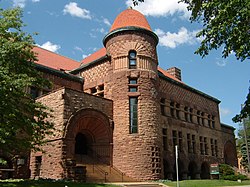University of Minnesota Old Campus Historic District
|
University of Minnesota Old Campus Historic District
|
|

The Richardsonian Romanesque Pillsbury Hall within the Old Campus Historic District.
|
|
| Location | Minneapolis, Minnesota |
|---|---|
| Built | 1886-1907 |
| Architect | Leroy Buffington, Harvey Ellis, J. Walter Stevens, Reed and Stem, Clarence H. Johnston Sr., et al. |
| Architectural style | Renaissance, Queen Anne, Romanesque |
| NRHP Reference # | 84001463 |
| Added to NRHP | August 23, 1984 |
The University of Minnesota Old Campus Historic District, listed on the National Register of Historic Places, includes a number of buildings on the Minneapolis campus that date back to the oldest days of the university.
Originally built as the Mechanic Arts building. The Mechanic Arts Building (Eddy Hall, 1886, 1903) is the oldest building within the district, as well as the oldest extant building on the Minneapolis Campus. It was constructed in 1886 according to designs by Minneapolis architect Leroy S. Buffington. Executed in the Queen Anne mode, the building is three stories in height on a high basement; a square tower at the northwest corner dominates the entry. The building is constructed of red brick with red sandstone trim. It is essentially rectangular in plan. Dominant features include the multi-gabled roof, high double-hung windows, panels of patterned brick, and iron cresting and a weather vane on the tower.
Erected at a cost of $30,000, an addition was made to the building in 1903 for an additional $10,000. The building originally housed the mathematics, drawing, civil-municipal-structural engineering departments, as well as testing laboratories. The Mechanic Arts Building has been renamed Eddy Hall in honor of Henry Turned Eddy, former professor of engineering and mathematics and later Dean of the Graduate School.
The first Law School building, itself founded in 1888. The Law School later moved to Fraser Hall and then to Mondale Hall. It is named after William S. Pattee, the first dean of the law school.
Originally named Science Hall, and named for Governor John S. Pillsbury. Harvey Ellis, Buffington's assistant, was responsible for the Romanesque details in the design. Ellis was inspired by Henry Hobson Richardson, but the building also contains elements of the Prairie School, Arts and Crafts, Gothic, and Victorian styles. The building is built with two different colors of sandstone. The buff-colored sandstone is from quarries near Banning State Park, while the red sandstone is from the Fond du Lac formation. The clay tile roof and copper eaves serve to protect the sandstone from the infiltration of water, and they also add to the appearance of the building. Reflecting its earthen architectural elements, the building is the home of the Newton Horace Winchell School of Earth Sciences.
...
Wikipedia


